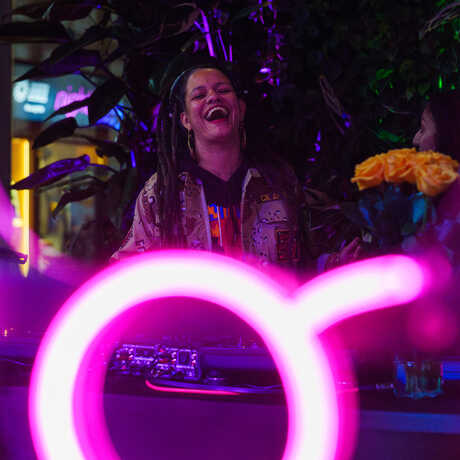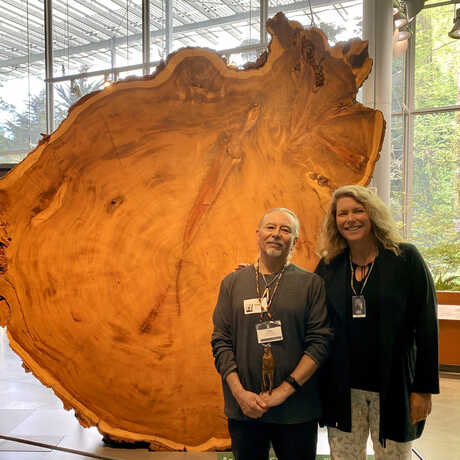Tomio Iwamoto: Six Decades of Deep-Sea Discoveries

Dr. Tomio Iwamoto, an emeritus curator of ichthyology and an Academy Fellow, is 84 and technically retired, but still bikes to work across the Golden Gate Bridge twice a week. (“It’s an e-bike,” he adds modestly.) When we met for coffee earlier this month, he was accompanied by an undescribed grenadier species in a giant specimen jar, a folder bulging with photos, and a faint (and not altogether unpleasant) aroma of ethyl alcohol. By the end of our expansive conversation, I was ready to renounce blogging and start over as his 40-something intern.
This May, as we celebrate Asian American and Pacific Islander Heritage Month at the Academy, we have an opportunity to honor the Academy’s diverse staff, including experts like Iwamoto. The Q&A below contains excerpts from our conversation on everything from his internment during World War II to his six-decade odyssey exploring the world’s oceans for mysterious deep-sea grenadiers.

First, let’s go over the basics. Where were you born? Can you tell me about your family?
Well, I was born in 1939 on 10th Street in downtown Los Angeles.
I'm a second-generation Japanese American. My folks were born in Japan and illegally immigrated to the United States. My father stole away on a freighter in 1928. I don't know if it was a banana boat or not, but he did eat mostly bananas during the voyage. He led quite an adventurous life, but unfortunately I don’t know too much about it because I failed to learn enough Japanese to communicate with him well.
My mother was born in Japan, but came to the United States after taking on the identity of her older sister who was born here but died young.
My parents married in 1936, and their first child, a girl, was born in ‘37. A second girl was born in ‘38, and I was the third one in ‘39. My brother was born in a relocation camp in Heart Mountain, Wyoming in 1943.
Pardon my ignorance, but is a relocation camp the same as an internment camp?
Yes, it was euphemistically called “relocation” or “internment.” It was really a concentration camp.
In February of ‘42, Executive Order 9066 was issued by Franklin Roosevelt [resulting in the forced removal of 122,000 Japanese Americans from the West Coast to concentration camps farther inland]. We were rounded up and sent to the Pomona Fairgrounds where we were housed in horse stables. We lived there for a few months and then were sent to Heart Mountain where we stayed until 1945.

Do you have any memories of your time in Wyoming? Were you conscious of what was happening?
I was too young, and in fact, I probably enjoyed it because we were out in the boonies. [Laughs.] I recall looking out beyond the barbed wire fences and seeing wild horses. That was a real thrill.
[Heart Mountain] was by the Shoshone River, and I recall on one trip my father and some others took a group of us kids to the river. I distinctly remember entrapping some fishes in the shallows and [being] enthralled with finding them. I think I got an appreciation for nature out there.
But it was a different kind of life, you know. We were in a barracks. [They] were 20 feet wide by 60 feet long, with three separate rooms of 20 feet each, and each of these had a potbelly stove. And no plumbing inside. I remember we had chamber pots because in the middle of the night, during a snowstorm, you didn't want to go out to the toilet facility.
These were tar paper barracks—the only protection from the elements was that tar paper wall.
Looking back, how do you feel about it now?
When I began to learn more about what happened, I realized the injustice. [Internment] was primarily due to racism; the reason we were interned was not for military security. This did not happen to the Italians or the Germans who were more selectively picked out for internment. I really feel sorry for those who lost so much, [like] Pearl Sonoda.

What got you started on the ichthyology track?
That’s pretty easy. My father loved to fish. We would go fishing and camping all the time in Southern California. We used to go to the San Gabriel River every opening day of trout season, and fished for mackerel off the piers [in Newport Beach and Huntington Beach].
I can remember really getting into fishing literature. We used to go to the LA City Library a lot and I got hooked on fishing books. I subscribed to Field & Stream and Outdoor Life and Sports Afield. My heroes weren’t football players but [fishing editors] like AJ McClane, Ray Bergman, and Ted Trueblood.
How did you zero in on grenadiers?
After I got out of the military in 1962, I took a job as a fishery biologist with the Bureau of Commercial Fisheries [now the National Marine Fisheries Service] in Pascagoula, Mississippi. Part of the job was to spend three to five months at sea, from Beaufort, North Carolina, through the Gulf of Mexico and Caribbean and down to the northern shore of South America.
When we went out to explore the depths, we couldn't identify a lot of the species [because] so little was known at the time about deepwater fishes. I started working on [grenadiers] because it was one of the groups that constituted a lot of the biomass of the fishes we caught. My interest grew and grew and became my lifelong research project.

When did you join the Academy?
My first job here was in the summer of 1967 working on a National Science Foundation grant to move the George Vanderbilt Foundation collection of fishes housed in a quonset hut on the Stanford campus to the Academy. I got this temporary position because Bill Eschmeyer and I were classmates at the University of Miami, and he had recently become the new assistant curator of ichthyology at the Academy.
After stints at the Bureau of Commercial Fisheries and two semesters teaching at Oregon State, I returned to the Academy in 1972 as assistant curator of ichthyology.
Tell me a couple of swashbuckling tales from your career and travels.
Over the years I made five separate cruises to West Africa on the Norwegian fishery research vessel, Dr. Fridtjof Nansen. The struggle was that I didn't have a way to bring specimens back…except in my luggage. The first time I came back, I had a suitcase full of specimens preserved in formalin—and some of the containers started to leak! It smelled like crazy. After that trip, I made sure I had everything in alcohol because the smell wasn't nearly as bad.

In 2011, I was working on specimens at the National Museum in Tokyo. It turned out Emperor Akihito was there at the same time. He was an ichthyologist, and the authority on gobies. And so myself and my good friend and colleague Martin Gomon, the curator at the Melbourne Museum, were invited to have tea with the Emperor! Unfortunately, I wasn't able to take any photographs. A couple weeks earlier, Hillary Clinton had also been visiting Japan, but when she asked for an audience with the emperor, he refused.
So what’s the grand total for species you have discovered or described?
I lost count after about a hundred. But that’s nothing compared with Brian Fisher’s ants and Terry Gosliner’s nudibranchs—those number in the hundreds!
You seem just as busy post-retirement as you were pre-retirement. What are you working on these days?
I continue to work on my grenadiers. A lot of the material that I had examined in Russia in 1988 was from the Indian Ocean, which is still very poorly known. I started collaborating again with my colleague, Artem Prokofiev, at the Russian Academy of Sciences, and we’ve described quite a number of new species already.
I was also thinking about updating my book, but I'm not interested in spending all that time. I have other interests. I wanna go fishing.




